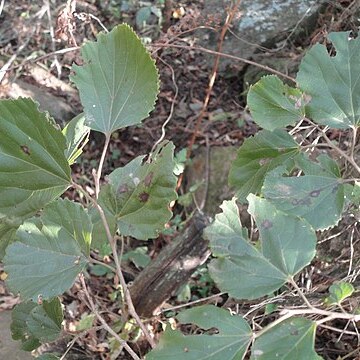Shrub (rarely subscandent) or tree, 2–6(–20) m. tall; bark grey to brownish.. Branchlets pilose to densely soft-hairy to velutinous at tips, lower parts glabrescent.. Leaf-blades ovate to elliptic or broadly reniform, apex shortly acuminate to obtuse or retuse, base rounded to cordate, firmly chartaceous to thinly coriaceous, densely soft-hairy to velutinous on both faces, sometimes glabrescent with age, particularly above, or almost glabrous, margin glandular-serrate-crenate, or more rarely-subsinuate-dentate, 2.5–8.5(–12) cm. long, 2.5–7.5(–12) cm. broad, 5–7(–9)-nerved from the base; nerves raised mainly beneath, veins ± transverse, their network with the veinlets not much conspicuous; petiole 0.8–1.5 cm. long; stipules foliaceous, lanceolate to transversely elliptic, persistent for some time, up to 3–10 × 2–18 mm.. Flowers small, sessile, densely pubescent, solitary or mostly in glomerules, these arranged along a slender rhachis, forming axillary spike-like racemes 2–5 (in the ♂ ones up to 9) cm. long.. Sepals subovate-lanceolate, 1–1.5 mm. long.. Petals subovate-elliptic, 1.5–2 mm. long.. Male flowers: stamens 10–15; filaments thick-filiform, laxly patently hairy, 2–4 mm. long; anthers ± 0.3 mm. across.. Disk-glands 4 or 5, thick, subquadrate, glabrous.. Female flowers: disk-glands 4, squamiform.. Ovary elongate-ovoid, glabrous, 1 mm.; styles 3, ± 1 mm. long.. Capsule sub-trigonous-ovoid, 2.5–3.5(–5) mm. long.. Seeds few, ellipsoid, 2–3 mm. long.
Tree, 3-10 m high, dioecious. Leaves alternate, simple, petiolate; circular or broadly obovate, margins serrate, 5-7-nerved from base; stipules sometimes foliose, caducous. Flowers unisexual. Male flowers in panicle, sepals and petals 4 or 5, marginal disc glands opposite each sepal; stamens 9-16, inserted in threes or fours alternating with disc glands; anthers small, subglobose. Female flowers spicate, sepals and petals 4; disc or marginal scale-like glands; styles 3, short. Flowering time Sept.-Apr. Fruit a dry, 3-valved capsule. Seed with red aril.
A shrub or small tree. It usually grows 2-6 m tall. It can lie along the ground and also grow taller. The bark is grey to brown. The small branches are softly hairy. The leaves are round and have 5-7 nerves spread out like fingers on a hand. The leaves are 2.5-8.5 cm long by 2.5-7.5 cm wide. Male and female flowers are separate. The flowers are small and hairy. They are in spike like groups 2-5 cm long in the axils of leaves. The fruit are oval and 5 mm long by 3 mm wide. They have 3 valves. There are 1 or 2 seeds.
Dioecious, small tree to 10 m. Leaves round, toothed, 5-7-veined from base. Flowers in axillary spikes or panicles, 4-or 5-lobed, greenish.


